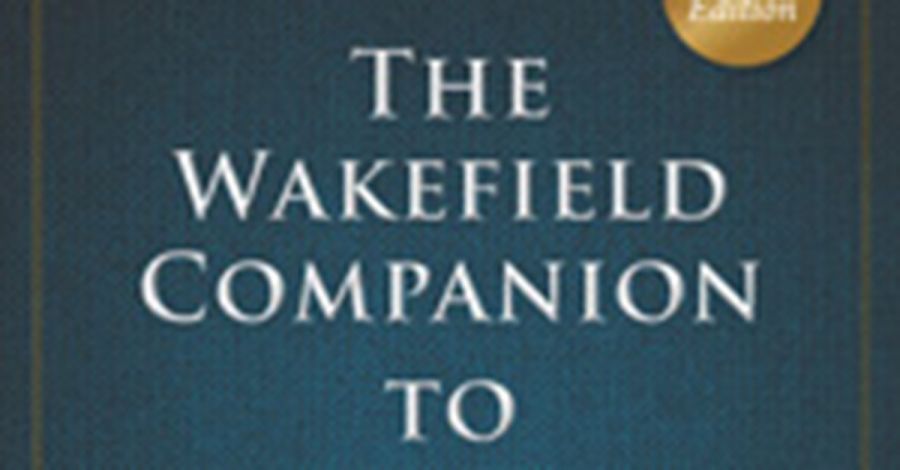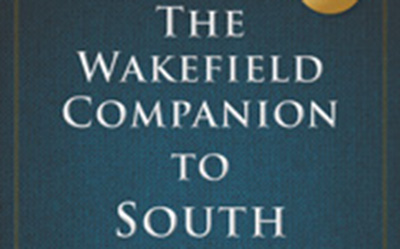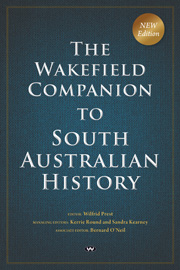
- Free Article: No
- Contents Category: Australian History
- Review Article: Yes
- Article Title: Murdoch, Unaipon and OAFs
- Article Subtitle: A timely new reference to South Australia
- Online Only: No
- Custom Highlight Text:
The Wakefield Companion to South Australian History announced itself in 2001 as ‘a landmark publication, the first such work of reference for any Australian state or territory’. This new edition, which adds entries, updates others, and lands with a thump at almost 200 pages more than the previous volume, is especially timely in the wake of the Covid-19 pandemic, which magnified awareness of the differences between the histories and cultures of the Australian states.
- Featured Image (400px * 250px):

- Alt Tag (Featured Image): Frank Bongiorno reviews ‘The Wakefield Companion to South Australian History’ edited by Wilfrid Prest
- Book 1 Title: The Wakefield Companion to South Australian History
- Book 1 Subtitle: Second Edition
- Book 1 Biblio: Wakefield Press, $70 pb, 812 pp
- Book 1 Cover Small (400 x 600):

- Book 1 Cover (800 x 1200):

- Book 1 Readings Link: https://www.readings.com.au/product/9781923042551/the-wakefield-companion-to-south-australian-history--2024--9781923042551#rac:jokjjzr6ly9m
South Australia is a rather different place almost a quarter of a century on from that first effort. The state’s famous car industry has gone, with Holden’s closure in 2017 (Mitsubishi went in 2008). The Kelvinator factories, having stopped making fridges, limped on under Swedish ownership, turning out air conditioners for just a few years early this century. The Simpson family got out of the washing machine business in the mid-1980s, and Hills, creator of the famous clothes hoist, entered voluntary liquidation in 2023. The state’s population growth has been slower, and its population is older and poorer, than that of any other mainland state. If South Australia is ‘exceptional’, as some have argued in praising its virtues, it is now certainly not so in an entirely good way.
The longer essays, on themes ranging from ‘Aboriginal Policy and Administration’ through ‘Health’ and ‘Industrialisation’ to ‘Science’, ‘Social Structure’, ‘Water’, and ‘Wheat’, provide authors with opportunities to stand back a little from the detail, and often to generalise with force and insight. Peter Bell, on ‘Architecture’, does a little gentle myth-busting: ‘There has probably never been a time when Adelaide had more churches than hotels’; Arthur Tideman, on ‘Pests’, is poetic in suggesting that the colonists ‘viewed wilderness as country that God had forsaken’, but prosaic in reporting that the second law passed by the new Legislative Council in 1851 was the Scotch Thistle Act. It is a pity that there is no entry on slavery, given the research that historians have undertaken in recent years on Australian connections to that oppressive institution. The British government compensation received by the Stirling family from their slave holdings in the wake of abolition is mentioned in the entry on them, but there is only silence on the pioneering Angas family, which also benefited from the scheme.
The editors, in line with the Australian Dictionary of Biography’s practice, include dedicated entries only on the dead, which means that we now have an affectionate portrait from University of Adelaide law professor John Williams on his old friend and colleague John Bannon, long-serving premier and later a political historian, biographer, and university college master. There are also entries on historians such as Eric Richards and Helen Jones but, oddly, not on Jill Roe, the great South Australian social historian and biographer of Miles Franklin, or George Rudé, internationally renowned practitioner of ‘history from below’ (who spent a decade of his career at universities in Adelaide).
The ban on the living means that Rupert Murdoch misses the bus, but he and his crusading editor at the News, Rohan Rivett, appear in the entry on the controversy involving Aboriginal circus worker Rupert Max Stuart, sentenced to death (commuted, after a public campaign) for the murder of a nine-year-old girl. Among the Labor Party’s dead, it is odd that we have an entry on senator Jim Toohey but none on the formidable Clyde Cameron, Murdoch’s regular lunch companion in the 1950s, or on Mick Young, each of whom played a critical role in the making of the Whitlam government.
First Nations peoples are well represented, reflecting shifts in historical research over the past half century. Many entries recognise a deep history stretching over millennia, but there are also compact biographical entries. Coverage includes not only well-known figures such as the ‘Australian Leonardo da Vinci’, David Unaipon, but also others less widely known than the man whose head appears on the $50 note. The celebrated historian and genealogist Doreen Kartinyeri, active in the failed campaign to stop the construction of the Hindmarsh Island Bridge in the 1990s, is among those who appear in this edition. Such entries are brief but taken together, and read alongside the stories of missionaries, anthropologists, ethnographers, and administrators, they disclose much about a First Nations history of suffering, survival, and success.
In such ways, the Companion’s scope ranges beyond the venerable patriarchs from the OAFs (Old Adelaide Families). To be sure, you will find the recurrence of names such as Angas, Barr Smith, Bonython, Downer, Dutton, Elder, Hawker, and Mortlock; their power, wealth, and philanthropy have played a formative role in shaping economic, political, and cultural life. (Bizarrely, even the completion of Parliament House was indebted to a Depression-era donation of £100,000 from John Langdon Bonython.) But the book also captures both the diversity of earlier times, in its exploration of the German presence and influence, as well as something of the transformation of recent decades, which saw a former Vietnamese refugee, Hieu Van Le, become governor in 2014.
The historian Douglas Pike’s 1957 characterisation of South Australia as a ‘paradise of Dissent’ resounds in the Companion. Authors do, however, prick some of the conceits about the state’s progressive traditions. Indigenous people were massacred as well as summarily executed. Poverty, crime, unemployment, and inequality have figured from the earliest years, despite the utopian ambitions that drove colonisation. South Australia was ahead of the pack in granting women political rights, but well behind it in actually getting them into Parliament, as late as 1959. It brought up the rear on the introduction of compulsory voting (1942) and full adult suffrage for the Legislative Council (1973), and it maintained a notoriously rigged lower-house electoral system, known as the Playmander (after its main beneficiary, Thomas Playford), from the mid 1930s until the late 1960s. But these same years also saw the South Australian Housing Trust in full flight, a remarkable contribution on the part of government to building homes during a time of ambitious industrialisation and immigration.
Religious pluralism has made an enduring mark on what Jenny Tilby Stock astutely describes as ‘South Australia’s generally sedate and civilised political culture’. Religious affiliation formed a foundation for a rich associational culture; South Australians have been notable joiners and its élites have taken public service seriously. The reputedly heavy influence of Nonconformist Protestantism, and the much lighter imprint of Catholics, receive reinforcement here. Still, it is notable that South Australia produced the country’s two most famous Catholic nuns, Mary MacKillop, a saint, and Janet Mead, a singer – the latter nominated for a Grammy for ‘The Lord’s Prayer’ but beaten by Elvis Presley’s ‘How Great Thou Art’. (The Companion’s system of updating entries unfortunately fell down in the case of MacKillop, for it still has her one miracle short of the full sainthood, which was proclaimed by Pope Benedict XVI in 2010.)
Ideas have also mattered, at least to enough people for enough of the time, for a striking number of South Australians to have made a national and sometimes international mark. Its educational institutions, some run by churches and others by government, were strong; several of them, such as the University of Adelaide, were open to the talent of women as well as men. The achievements of professional women, such as early childhood education authority Lillian de Lissa, an internationally renowned figure, and doctor and health reformer Helen Mayo, are notable.
Identities claimed by Australians as national property, such as C.J. Dennis and Roy Rene (‘Mo’), were South Australian natives before their origins became obscured by their fame. The procession of distinguished social reformers, entrepreneurs, scientists, artists, actors, musicians, sports stars, aviators, explorers, writers, and academics sometimes threatens to overwhelm. But amid such glittering talent, it still seems remarkable that this small and rather isolated place could produce a father-and-son team of Nobel Prize winners in physics as early as 1915, even allowing that the Braggs had by then moved on to British universities.
The national magazine in which this review appears also had its origins in Adelaide in 1961. It is in such subtle and sometimes forgotten ways that South Australia’s particular history has flowed into that of the nation and helped form Australia’s place in the wider world. The Wakefield Companion to South Australian History, with its hundreds of contributors drawing on a deep well of expertise, is a grand collective project that allows us better to see these connections.


Comments powered by CComment